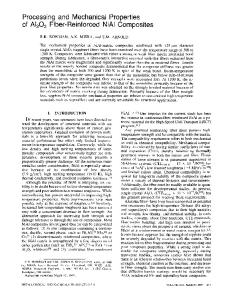Fabrication and Mechanical Properties of Ni 3 Al-Al 2 O 3 Composites
- PDF / 2,413,919 Bytes
- 6 Pages / 420.48 x 639 pts Page_size
- 73 Downloads / 417 Views
FABRICATION AND MECHANICAL PROPERTIES OF Ni3 AI-A 20 3 COMPOSITES C. G. McKAMEY,e G. L POVIRK,** J. A. HORTON,* T. N. TIEGS,* AND E. K. OHRINER* *Metals and Ceramics Division, Oak Ridge National Laboratory, Oak Ridge, TN 37831 "**Brown University, Providence, RI 02912 ABSTRACT The objective of this study is to develop a metal-matrix composite based on the intermetallic alloy Ni3Al reinforced with A12 0 3 fibers, with improved high-temperature strength and lower density compared to the matrix material. This paper summarizes results of initial fabrication and mechanical tests on specimens produced using IC-15 [Ni-24% AM-0.24% B (at.%)] and IC-218 [Ni-16.5% Al-8% Cr-0.4% Zr0.1% B (at.%)], with 20 vol. % A120 3 fibers. Fabrication methods include both hot-pressing and hotextrusion. Mechanical tests include four-point bending and tensile tests. The integrity of the fiber-matrix interface was studied and correlated with mechanical properties. Tensile ductilities of approximately 10% at room temperature were achieved for Ni3AI/AI20 3 composites with controlled material processing and interfacial structure. Fabrication of composites by hot-extrusion produced better tensile properties at room temperature, but superplastic behavior (i.e., low strengths, high ductilities) at 1000*C. INTRODUCTION Whisker-reinforced metal matrix composites have shown the potential to lead to improved mechanical properties when compared to the unreinforced matrix material [1]. A boron-doped Ni 3AI alloy with addition of chromium, which alleviates oxygen embrittlement at high temperature, appears to be an excellent candidate for the matrix material in a high temperature composite [2,3]. A gas pressure liquid metal infiltration technique for producing A120 3 fiber reinforced Ni 3AI composites has recently been described [4]. In that study, a composite containing 33 vol% of Dupont FP fibers fractured at 890 MPa, which is approximately three times the yield strength of the unreinforced matrix alloy [4]. In this investigation, composites of Ni3Al with chopped A120 3 fibers were fabricated by hot-pressing and by hot-extrusion. Alumina fibers were chosen as the reinforcement because prior investigations have
shown that nickel aluminides react chemically with silicon carbide to form nickel silicides [5]. The effects of the AI20 3 fibers on the matrix microstructure were examined by optical microscopy and transmission electron microscopy (TEM). In addition, the matrix/fiber interface was characterized by TEM, with particular attention directed toward finding evidence of chemical reaction at the interface. Preliminary tensile and bend tests were carried out and the fracture modes were characterized. EXPERIMENTAL PROCEDURES Dupont FP Type I fibers, 20 pm in diameter, containing 1123.91 > 1501.7c > 1292.1c 405.4
1/1350/20.7
550.9
> 1009.4c
1/1335/20.7
508.8
>848.1c
1/1350/20.7
535.7
>946.0•
1.5/1170/20.7
689.5
905.3
1.5/1200/20.7
490.2
692.3
1.5/1300/20.7 .17/1200/55.2
464.7 550.2
>849.5c 940.5
'Fiber was annealed in graphite furnace, ar
Data Loading...











